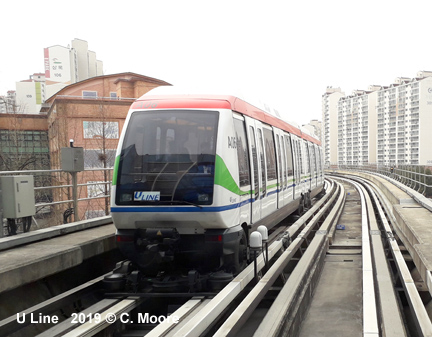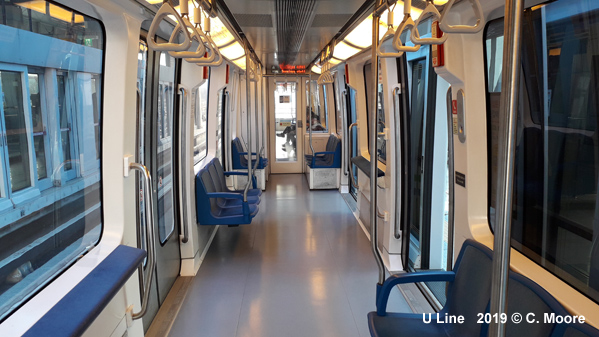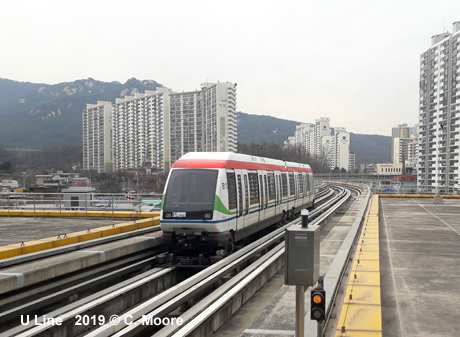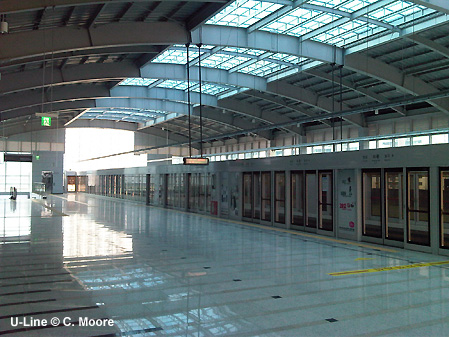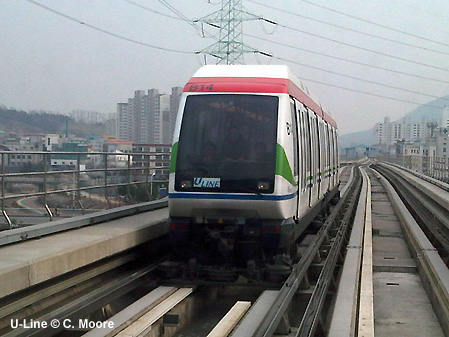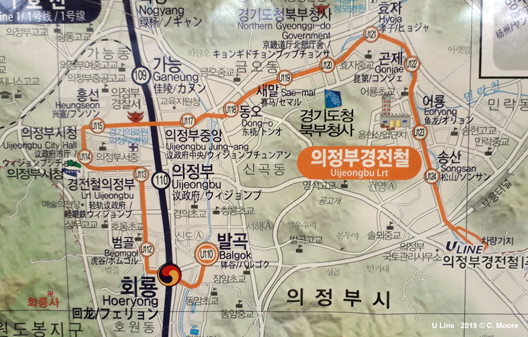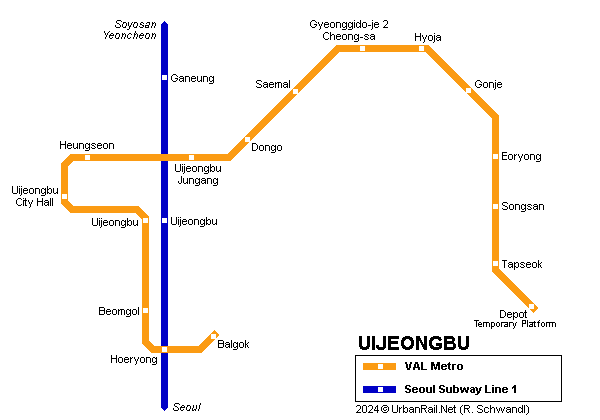
| UIJEONGBU |
|
Uijeongbu is a city with half a million inhabitants just north of Seoul. Siemens built a VAL system which functions as a feeder to Seoul's Subway Line 1 northern branch, which has a total of six stations in Uijeongbu. An interchange station was built at Hoeiryong. The original line is completely elevated, 11.1 km long and includes 15 stations. It is operated with 15 2-car trainsets of VAL 208 NG vehicles. The turnkey contract was awarded in September 2006 and, labelled the 'U line', it opened on 1 July 2012. On 30 Oct 2021, passenger service (with a train about every 25-30 minutes) was extended to Depot Temporary Platform, adding 0.8 km to the original line.
|
| Links |
|
Uijeongbu LRT (Official Site) Seoul Subway at UrbanRail.Net
|
| Report |
|
In March 2019, Craig Moore reports: Uijeongbu is a city of half a million people located to the north east of Seoul in Gyeonggi Province (but within the Seoul Capital Area). In many senses, this is a satellite city for the Korean capital, which is directly accessed by Line 1 of the Seoul Metro (45mins). Surrounded by mountains, Uijeongbu is located in a narrow valley and, in both historical and contemporary contexts, it is seen as a strategic military area between the north and Seoul. As such, there is a strong US/Korean military presence in the city and Uijeongbu was the location of the fictional military hospital in M.A.S.H.! The narrowness of the lowland area has created a densely populated urban zone which is served by the meandering U-Line. This is an elevated, automated VAL line of 10.6km (revenue KM), hosting 15 stations. Services operate from 0500-0030 with base headways of 6mins. Unsurprisingly the busiest station on the system is Hoeryong, which provides transfer to Line 1 of the Seoul Metro, via an elevated walkway. There are ticket gates prior to accessing and leaving the U-Line station here and information boards say there is a 400 Won supplement to change systems, but when I tapped my card it said "0 Won will be deducted" so I'm unsure if this was a past fare differentation, as was Incheon . The orange line identifier is dominant in stations which are functional but quite basic and are topped by an arched roof supported by light blue girders. All stations are pretty identical (except Hoeryong which is larger and has deeper, longer platforms). Station are accessed via walkways to the mezzanines which have ticket machines (1350 Won-€0,90), barriers and vertical strip map. Stairs or escalator provide access to the side platforms which have glass side walls, affording lovely views of the surroundings. There is little of note on platforms. A strip map in orange tops the platform screens, there is little seating or colour, no RTI (a horn sounds when a train is approaching) and no platform information boards (nor is there any hard copy information available). The stock consists of two-car VAL sets built by Siemens with a white exterior and red, green and blue stripes. Internally, they are very clean and have side seating and plentiful standing areas. There is a backlit strip map (Korean only) and audio announcements in Korean and English. The front seats afford great views of the dense city area, the surrounding mountains and the system infrastructure, but these are very much in demand! The line takes 20mins to traverse and trains run quite rapidly. In the central area around City Hall there are tight corners but most of elongated ‘n’ shaped line has long straight stretches with good line speeds. Interestingly at Songsan, most of the footfall is for the housing blocks located to the east and so most passengers stay on the train and wait for the switch back to the eastern platform, rather than negotiate the stairs. In summary, although the U-Line is quite a distance from central Seoul, it is a worthwhile detour for ‘enthusiasts’ and is a useful, if under used, addition to the immense, impressive and growing array of urban rail lines in the capital area. |
2008 © UrbanRail.Net by Robert Schwandl.
